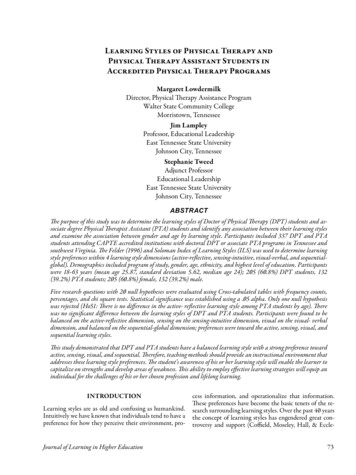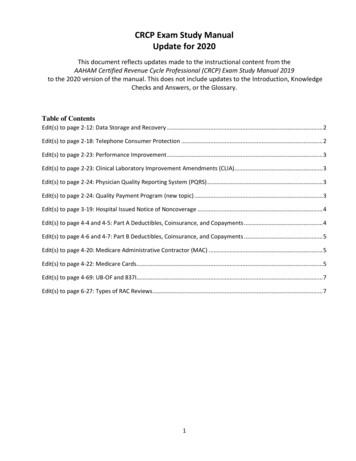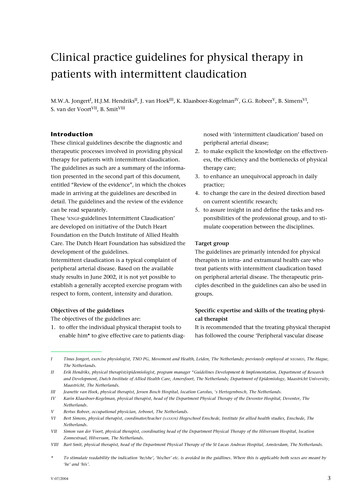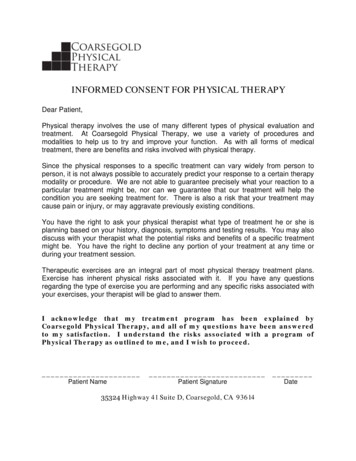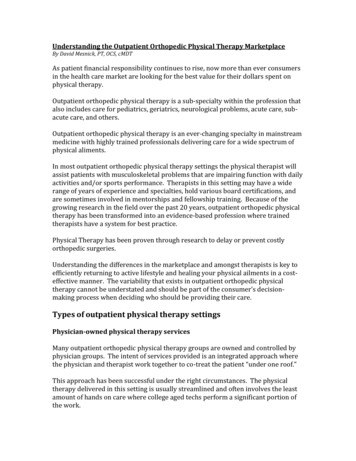
Transcription
Understanding the Outpatient Orthopedic Physical Therapy MarketplaceBy David Mesnick, PT, OCS, cMDTAs patient financial responsibility continues to rise, now more than ever consumersin the health care market are looking for the best value for their dollars spent onphysical therapy.Outpatient orthopedic physical therapy is a sub-specialty within the profession thatalso includes care for pediatrics, geriatrics, neurological problems, acute care, subacute care, and others.Outpatient orthopedic physical therapy is an ever-changing specialty in mainstreammedicine with highly trained professionals delivering care for a wide spectrum ofphysical aliments.In most outpatient orthopedic physical therapy settings the physical therapist willassist patients with musculoskeletal problems that are impairing function with dailyactivities and/or sports performance. Therapists in this setting may have a widerange of years of experience and specialties, hold various board certifications, andare sometimes involved in mentorships and fellowship training. Because of thegrowing research in the field over the past 20 years, outpatient orthopedic physicaltherapy has been transformed into an evidence-based profession where trainedtherapists have a system for best practice.Physical Therapy has been proven through research to delay or prevent costlyorthopedic surgeries.Understanding the differences in the marketplace and amongst therapists is key toefficiently returning to active lifestyle and healing your physical ailments in a costeffective manner. The variability that exists in outpatient orthopedic physicaltherapy cannot be understated and should be part of the consumer’s decisionmaking process when deciding who should be providing their care.Types of outpatient physical therapy settingsPhysician-owned physical therapy servicesMany outpatient orthopedic physical therapy groups are owned and controlled byphysician groups. The intent of services provided is an integrated approach wherethe physician and therapist work together to co-treat the patient “under one roof.”This approach has been successful under the right circumstances. The physicaltherapy delivered in this setting is usually streamlined and often involves the leastamount of hands on care where college aged techs perform a significant portion ofthe work.
A typical number of patients seen by each therapist in this setting in a regular 8hour day is approximately 20-25.The average amount of hands on time with the PT is 15 minutes (or less). Theduration of care is typically 16 total visits.Insurance companies reimburse procedure codes in a physician-owned centerroughly 1.5-2x’s more than in non physician-owned centers, making them extremelyprofitable.The following is a literature review of Physician owned practices:-Up to 45% more visits for the same diagnosis in Physician owned practices.-30-40% greater cost per patient in physician owned practice. (Mitchell, J.et al. JAMA.1992)-Authors note greater use of PT care extenders (PTA, aides, techs) increased visits andcost vs. use of PT alone. (Resnik, L et. Al. Health Res ED Trust. 2006)-Clinics using only PT demonstrate superior outcomes to those using more careextenders. (Resnik, L. et al. Phys Ther. 2011)-Patients referred by MD who had a their own practice were twice as likely to bereferred to PT, Received a higher % of passive care inconsistent with the medicalliterature, incurred 35% greater cost due to incident to billing. (Mitchell, J. Physicianself referral of PT services. 2015)In-network corporate physical therapyAround 2010, physical therapy performed in an “in-network” setting wasconsistently profitable if the practice was well managed.Because of declining reimbursement by insurance companies and an increase inphysician-owned centers, survival in the “in-network” marketplace has beenchallenged significantly.Many companies in the corporate PT world have hired business consultants tocreate important metrics in order to keep their centers profitable. These metricsinclude setting visit goals for their therapists and incentivizing them by seeing morepatients.In order to keep payroll expenses down, these businesses generally heavily recruitnew graduates who they can pay less and incentivize with signing bonuses,residency programs, and student loan assistance with a multi-year commitment.A typical number of patients seen by each therapist in this setting in a regular 8hour day is approximately 16-20 .The average amount of hands on time with the PT is 20 minutes with the duration ofcare typically 12-16 total visits.
Physical therapists in this setting are usually training for or have obtained sometype of advanced certification and may be involved in a residency program offeredby their company. It is very common to have college-aged techs to assist with carein this setting particularly in high volume clinics.The owners of these clinics can range from non-clinical physical therapists to hedgefunds.In-network privately owned physical therapyOnce the gold standard for outpatient physical therapy, declining reimbursementhas made this setting the most endangered.Many privately owned physical therapy groups have either sold their practices tocorporate firms or have just shut their doors. Other very well run privately owned“in-network” physical therapy centers have evolved by offering cash pay services orfinding their niche in the market. Declining reimbursement has made it virtuallyimpossible to budget these businesses because of the variability that exists eachyear in income dictated by insurance companies.Many physical therapists in this setting are leaders in their field and have advancedcertifications with 5 years experience.A typical number of patients seen by each therapist in this setting in a regular 8hour day is approximately 12-16.The average amount of hands on time with the physical therapist is 15-30 minutes,depending on the company. The duration of care is typically 10-12 total visits.Out-of-network physical therapyMany seasoned physical therapists who have established a reputation in the “innetwork” privately owned world have increasingly moved into an “out-of-network”model of physical therapy so that they can continue to practice in a way that is inline with their advanced training, values, and desires for patient care.This model eliminates the pressures created by the insurance companies andcorporate metrics to see more patients. It also allows the physical therapist toprovide skilled care in the unhurried environment that used to exist in the “innetwork” setting.Most physical therapists in this setting are leaders in their field and have advancedcertifications and training. Many therapists have 10 years experience andparticipate in mentoring and training new graduates.
Physical Therapists in this model typically have strong relationships with physiciansthat are like-minded.This model rarely incorporates techs and the services are provided almostexclusively by the physical therapist.A typical number of patients seen by each therapist in this setting in a regular 8hour day is 6-8.The average amount of hands on time with the PT is 45-60 minutes and the durationof care is usually the shortest at less than 10 visits.Patient responsibility is increased in this model as patients are required to payupfront and get reimbursed per their “out-of-network” benefits. With deductiblesand co-pays increasing each year, this model is becoming more and more attractiveto patients since they will be paying for the services regardless of whether theprovider is “in- or out-of-network,” while at the same time getting 2-3 times morehands on care with an expert physical therapist.SummaryBecause of the variability that exist in outpatient orthopedic physical therapy, it isimportant that patients evaluate their options before choosing who is the bestproviders for their care and recovery. It is encouraged that patients interview theirproviders prior to initiating a physical therapy programThe table below breaks down the various options available in outpatient orthopedicphysical kprivateOut-ofnetworkprivateAvg. Patients seenper day per PTAvg. time ofhands-on careTechs used20-2516-20 10-166-8 15 minutes 20 minutes15-30 minutes45-60 minutesYes-much ofthe treatmentYes-some of thetreatmentRareLevel of expertiseof PTVariable 5 yearsexperience iscommonDuration of care16 visits12-16 visitsMaybe-some tominimal amountof the treatment 5 yearsexperience iscommon.CommonlyIndustry leaders10-12 visits 10 yearsexperience iscommon.CommonlyIndustry leaders 10 visits
(total visits)Patient financialresponsibilityCopay anddeductibleCopay anddeductibleCopay anddeductiblePatient paysupfront/ isreimbursed without-of-networkbenefits (ifavailable)
Types of outpatient physical therapy settings Physician-owned physical therapy services Many outpatient orthopedic physical therapy groups are owned and controlled by physician groups. The intent of services provided is an integrated approach where the physician and therapist work together to co-treat the patient "under one roof."



